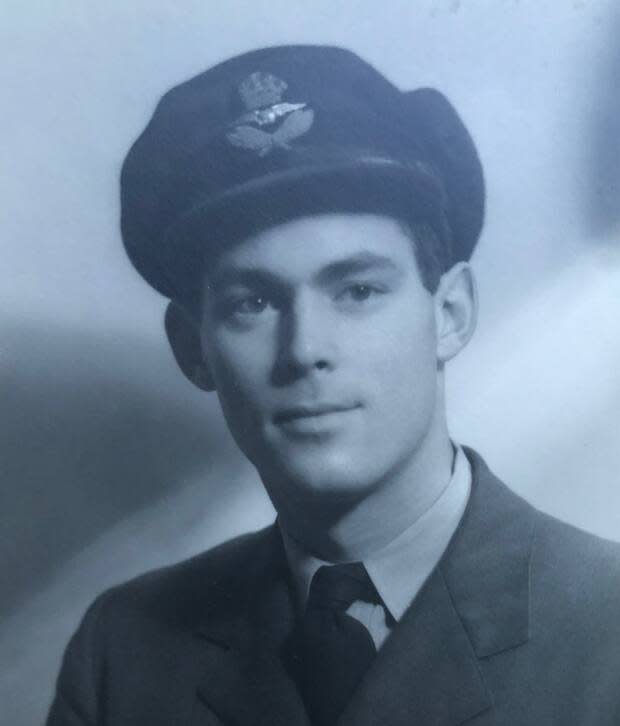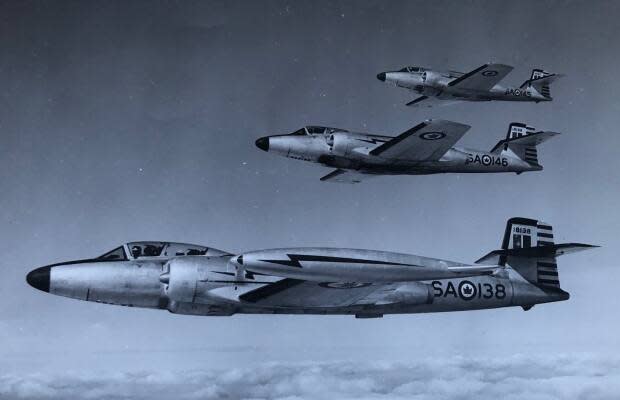How a northwestern Ontario pilot helped bring Queen Elizabeth's 1953 coronation to Canadians

Queen Elizabeth's coronation on June 2, 1953, was the first global event to be televised in North America on the same day it happened.
The final leg of the event footage's overseas journey was completed by George Nickerson, a pilot from Kenora, Ont.
Elizabeth succeeded to the throne on Feb. 6, 1952, when she was 25 following the death of her father, King George VI. She was 27 at the time of her official coronation.
As the Queen's 70th Jubilee approached, Rob Nickerson set out to find out whether the family legend about his uncle was true: "Stories my father would tell about this accomplishment that George Nickerson did — and that was to fly these tapes across the ocean and land them in Canada," Rob said.

The family's story wasn't exactly right.
The CF-100 fighter jet George Nickerson flew didn't have the fuel capacity to cross the Atlantic Ocean. But the truth, which was far more complicated, made Rob stand back in awe.
Nickerson, a wing commander, was stationed in Winnipeg, 200 kilometres west of Kenora, when the Royal Canadian Air Force ordered him to carry out a peculiar mission that would change what the world thought possible, both in and on the air.
Operation Pony Express
The mission, dubbed Operation Pony Express, would bring the British and Canadian air forces together, along with both countries' public broadcasters.
The British Broadcasting Corporation (BBC) committed to filming the 1953 coronation through a process it developed called "telerecording," which recorded the footage on a state-of-the-art flat-screen TV. The Royal Air Force's new Canberra bombers were enlisted to fly the film canisters to Canada.
Military historian Mike Bechthold said the military and communications technology was cutting edge at the time.
"They had to film it, they had to develop it. It had to go from the location where the filming was made in London to Heathrow Airport. And they made that transfer on a helicopter. It was then placed on a jet bomber. It was flown across the Atlantic Ocean," said Bechthold, who has a PhD in history from the University of New South Wales and degrees from Wilfrid Laurier University in Waterloo, Ont.
"It took 5½ hours to make that trip," he added. "They landed in Goose Bay, Labrador and at that RCAF base, they met a Canadian fighter, a CF-100, and the first fighter was piloted by Wing Cmdr. Nickerson."
Nickerson's role was to transfer the 17 canisters weighing 420 pounds (190 kg) into his CF-100 and fly from Goose Bay to St. Hubert, Que. From there, a helicopter would take them to the new Canadian Broadcasting Corporation (CBC) studio in Montreal, which had only started airing television programming nine months earlier.

In early planning stages, the British Air Ministry's chief information officer, L.M. MacBride, issued a letter to the ministry endorsing the plan as a chance to bolster respect for the military and support for the monarchy in both Canada and the U.S.
"It seems a wonderful opportunity of gaining worldwide publicity for the RAF while at the same time enhancing Britain's general prestige throughout the North American continent with so immediate a presentation of the coronation film," MacBride wrote.
It would be expensive for Canada's public broadcaster to employ the military. The entire mission cost $11,650, equivalent to nearly $1.5 million today. But using civilian aircraft would have taken 10 hours and CBC didn't have time to spare.
"For the CBC, the big importance was being first on the airwaves in North America," Bechtold said. "They wanted to scoop the Americans and resorting to commercial aviation, they couldn't count on scooping the story, but they'd probably come in second to the Americans, so they needed to do something different."
Making Operation Pony Express a military operation would take the same amount of time from door to door as it took for the Earth to spin, which would allow for the coronation to air in Canada at the same local time as events unfurled in London. That would allow CBC to be able to call the footage "live."
'A brilliant achievement'
Unbeknownst to CBC until deep in the planning process, the American network NBC had arranged with the English Electric Company to enlist a Canberra bomber from the Venezuelan military.
CBC beat the Americans to air by nearly half an hour. It took just over five hours for the bombers to land in Goose Bay and CBC began televising the event 2½ hours later, at 4:15 p.m. ET.
LISTEN | Here's the story of Operation Pony Express:
The CBC leaders were elated. A telegraph CBC chairman Arnold Dunton sent to the BBC described the mission as a " brilliant achievement" and the footage as having been made available "in a wonderfully immediate way."
To show thanks, CBC purchased a painting from Group of Seven artist A.Y. Jackson titled Indian Village Yellowknife. It was fitted with a plaque thanking the RCAF for its role in Operation Pony Express. The painting still hangs in the Winnipeg airbase today. It will be featured in a book Bechtold is publishing of 100 artifacts to commemorate the centenary of the RCAF in 2024.

Operation Pony Express almost didn't happen. Elizabeth was reluctant to allow the pomp and circumstance of the coronation to be televised throughout the Commonwealth, suggesting radio would be sufficient.
The BBC executives convinced her to let it go ahead, and according to the BBC, more people watched it through the new medium of television than listened to it on the radio.
Key moment for television
Alan MacEachern, a history professor at Western University in London, Ont., said that on both sides of the ocean, the coronation was among the events that established TV as a medium.
"It was one of those early moments that made people realize television was here to stay," he said.
"I know in Ottawa, for example, I'm not sure if it was television manufacturers or television dealers who actually made TVs available in schools in so that the coronation could be watched by schoolchildren. The numbers were a lot. It's really difficult to know whether to trust the numbers for TV viewers, but apparently 300 million people watched the coronation."
George Nickerson died in a CF100 crash the year after Operation Pony Express, but for his nephew Rob, ironing out the truth keeps the story alive.
"It was all true," said Rob. "It wasn't an urban myth or an urban legend in our family. The thing that has been sitting in my heart and in my mind for the last 60 years, that I just kicked over a stone and there was the truth, but the stone has been sitting here this long. It made me think, 'This is pretty cool. This is pretty cool — for him.'"


